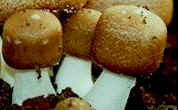

|
Today more and more people are turning to alternative therapies to combat diseases such as cancer and AIDS`s. Medicinal mushrooms in particular have been placed in the forefront as a viable and successful means of treating various ailments. Throughout the world, people have been utilizing mushrooms for the improvement and preservation of health. The Agaricus Blazei Murill, which is also commonly known as Sun's mushroom (Cogumelo do Sol), God's mushroom (Cogumelo de Deus), and Himematsutake is a mushroom that is originally native to a small village, named Piedade, mountain region of São Paulo state, Brazil. It flourishes in the powerful Brazilian sunlight that often exceeds 35-38 degrees Celsius. Agaricus Blazei Murill contains a powerful immunostimulant called beta glucans, a polysacchride (a chain of sugar molecules formed together to make larger sugars) known to enhance the body`s immune system.
Agaricus Blazei Murill was first noticed about 30 years ago when two researchers from Penn State University visited Piedade and discovered that the natives were very healthy with very low rates of disease and that a disproportionately high number enjoyed longevity. Further research by other researcheers such as Dr. Shobo Shibata and Dr. Tetsuo Ikegawa revealed the actual pharmacological actions of this mushroom. A Japanese-Brazilian farmer first discovered the Agaricus Blazei Murill in the summer of 1965. Since 1968, Dr. Takashi Mizuno Ph.D., has studied the bioactive substances in fungi, especially those related to anti-tumor active polysaccharides. They discovered that the Agaricus blazei Murril was rich in polysaccharide compounds, which assist in boosting the immune system. Research has found that the two principal polysaccharide compounds, which exist in Agaricus Blazei Murill, are ß(Beta) 1,3-D Glucan and ß(Beta) 1,6-D Glucan. During the 1980's and 1990's scientists conducted studies that have shown the Agaricus Blazei Murill mushroom to be an immune system stimulant which promotes the body's natural defense mechanisms to fight a variety of infectious agents, including cancer. The polysaccharide contained in Agaricus Blazei Murill vitalizes production of interferon and interleukin. This effect indirectly functions to destroy or prevent the proliferation of cancer cells.This refers to a cytosine inducing effect. Moreover, the experiments conducted by the researchers named above proved that this effect can also prevent viruses and other external factors from entering the tissue. Clinical results, obtained in collaboration with university researchers and hospitals since the report on the anti-cancer effect of Agaricus Blazei Murill was released at the general convention of the Japan Cancer Association in 1980, proved that many fungi polysaccharides only effect solid cancer and the polysaccharide of Agaricus Blazei Murill is effective against Ehrlich's ascites carcinoma, sigmond colonic cancer, ovarian cancer, breast cancer, lung cancer, and liver cancer, as well as against solid cancer. In March 1995, Dr. Kazunari Satake M.D., Ph.D., commenced a three-year clinical study with cancer patients. Dr. Satake announced the results of his research to the Japanese Cancer Congress in 1998. Researchers have found that the concentrations of Beta(ß) 1,3-D Glucan and Beta(ß) 1,6-D Glucan are higher in Agaricus blazei Murril than in any other mushroom types including Reishi, Maitake and Shitake. Other research has also shown that Agaricus blazei Murril is high in ergosterols, linoleic acid and palmitorenic acid as well as Vitamin B6 and B12.
Several
species of mushrooms, particularly maitake, reishi, and shiitake, have been
utilized medicinally in Asia. They have been used historically as
"adaptogens," or general tonics, to promote overall wellness and
vitality. There
are many botanicals that act as adaptogens (also known as biological response
modifiers) to assist the body in adapting to environmental and psychological
stress. Adaptogens, including medicinal mushrooms, benefit all of the important
systems of the body, including the nervous, endocrine, adrenal, and immune
systems, by increasing or decreasing their function, as needed, for maximum
health. Many
of the medicinal qualities of mushrooms can be traced to certain polysaccharides
they contain. Polysaccharides are large, complex branched chain-like molecules
built from many smaller units of sugar molecules. Increasingly, certain
polysaccharides in mushrooms are garnering attention for anti-tumor and
immune-stimulating properties. For example, the polysaccharide called
beta-glucan (found in several of the medicinal mushrooms) has been shown to
stimulate the immune system and activate cells that attack cancer. Dietary Supplements from Medicinal Mushrooms: Diversity of Types and Variety of Regulations
International Journal of Medicinal Mushrooms volume 2, Number 1 (2000) ABSTRACT: Many pharmaceutical substances with potent and unique health-enhancing properties were isolated recently from medicinal mushrooms and distributed worldwide. Many of them are not strictly pharmaceutical product ("real" medicines), but rather represent a novel class of dietary supplements (DSs) or "nutriceuticals." They are also known as functional or designer foods, nutraceuticals, phytochemicals, mycochemicals, and biochemo- preventatives. Mushroom-based DSs are products from either the mycelia or the fruiting bodies of mushrooms, and are consumed in the form of capsules, tablets, or extracts, and have potential therapeutic effects. We describe here the diversity of different DSs available today on a world market. Most of mushroom products of that sort are dried powders and extracts from naturally growing or commercially cultivated mushroom fruiting bodies, or dried or extracted biomass of mycelium grown in a solid state or in submerged culture. The clear advantages of using mushroom-based DSs in regard to safety (as opposed to herbal preparations) are: (I) The overwhelming majority of mushrooms used for production of DSs are cultivated commercially (and not gathered in the wild). This provides very good chances of proper identification, and for pure and unadulterated products. In many cases it also means genetic uniformity. (2) Mushrooms are easily propagated vegetatively, and thus keep to one clone. The mycelium can be stored for a long time, and the genetic and biochemical consistency may be checked after a considerable period of time. (3) The main advantage, in our opinion, is that many mushrooms that cannot produce fruiting bodies artificially are capable of growing in the form of mycelial biomass in submerged cultures. The problem is that DSs made from mushrooms are highly diverse, and there are currently no standard protocols for ensuring their product quality. There is a serious need for critical analysis, improved quality and legal control, which are essential both to increasing and maintaining consumer confidence, and to meeting the current and future standards set by the regulatory authorities. The usual criticism of DSs concerns standardization, that is, preparing herbs or mushrooms in a way that ensures the consistency and predictability of chemical composition and minimizes the deviations between different batches. This depends on numerous factors including cultivation conditions, composition of substrates, purity of ingredients, stability of active compounds, storage, etc. The regulations of DSs from herbs and mushrooms in a number of major industrial countries are analyzed. In 1991, the World Health Organization (WHO) published its "Guidelines for the assessment of herbal medicines." Regulatory steps taken by most developed countries are usually in accordance with those guidelines of the WHO. The present regulations of the United States [carried'out by the Federal Food and Drug Administration (FDA)] treat DS as a separate entity. After passage of the Dietary Supplements Health and Education Act of 1994, the FDA has issued a number of regulations that do not require the manufacturers of DSs to prove their effects and safety in very lengthy and expensive procedures of drug approval. On January 6,2000, the FDA issued its final regulations on structure/function (SF) claims for DS under the DSHEA of 1994. In these rules, a significant shift is made in relation to SF claims for over-the-counter drugs, including DS. In particular, the FDA has enlarged the range of SF claims by agreeing with the comments of the American Herbal. Nature has a place for everything Mushrooms,
during millions of years of evolution, have adapted to play a very special and
indispensable role in the ecosystem -- that of the recycler. Mushrooms secrete
digestive enzymes into the environment and then absorb the products of digestion
for their nourishment. This decomposition process benefits the ecosystem in two
ways: first, it decomposes dead plant and animal matter that, without the
mushrooms, would accumulate to unmanageable levels; and second, it returns
nitrogen, phosphorus, and other nutrients to the soil. In
addition, mushrooms, for the sake of their survival, have developed natural
substances to prevent microorganisms, such as bacteria and viruses, from
attacking them. Humans consuming certain mushrooms can also benefit from these
antimicrobial substances.
| ||||||||||||||||||||||||||||||||||||||||||||||||||||||||||||||||||||||